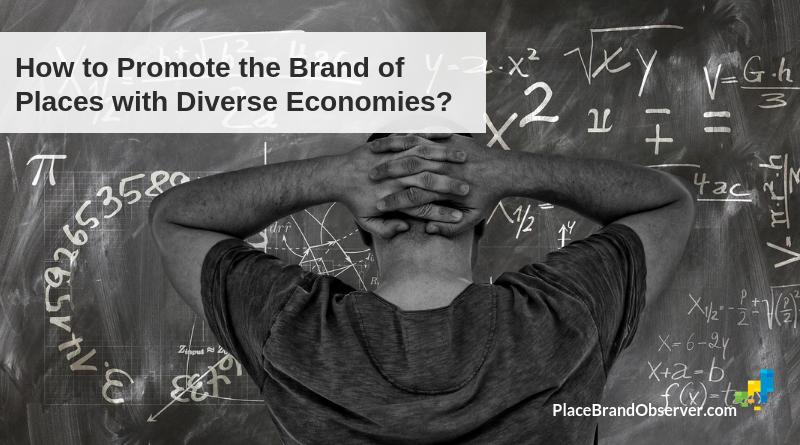How to promote the place brand of a city or region with a diverse economy without diluting the message?
That’s what a reader wanted to know. We asked our panel of place branding experts. Answers below (in alphabetical order – highlighted respondents are available for consulting, research or as speakers).
Anupam Yog
It does so by relying on a central ‘organizing idea’ that is distinct from ‘message’. In the case of Brand India, it is ‘fastest growing free market democracy’.
Aparna Sharma
Cities with a diverse economy would probably be the best examples of vibrant and nurturing ecosystems. The emphasis should be on values, the environment and the ecosystem that the place nurtures and inspires that makes such diversities possible. In India, the big metropoles like Delhi and Bombay are extremely good examples of such place brand strategies, where the emphasis is on people, the resilient ecosystem and values that help project these cities as places of multiple opportunities.
 Caio Esteves
Caio Esteves
I believe that all place brands need a diversified economy.
In fact, a good place branding project should look for new economic development vectors, aligned with a place’s vocation and identity.
This is the principle of optionality, which can lead to antifragility (Nassim Taleb), or rather an antifragile place.
Antifragility is a concept that goes beyond resilience, an approach that deals with uncertainty not as a problem, but as part of the process.
My hypothesis is that places and cities could benefit from adopting this mindset.
What is important is that the central concept, the shared idea that moves this place brand, is aligned with this diversity.
In this way we can have a central concept, and several directed messages that complement each other.
 Christopher Hire
Christopher Hire
By focusing on key strengths around a central theme. In my view, the place brand can only be centred around complementary messages – unless it’s a mega city like London or a large state or region.
For most smaller cities removing contradictory messages (such as sustainable and industrial) is essential. This can make stakeholder agreement harder in the short term, but such laser focus is worth it long term.
Place brands are lasers, not mirrors.
Ed Burghard
This is a question of strategic target definition and message management. The first assumption (which isn’t always valid) is that the place has done a good job of defining its brand promise. A good brand promise is authentic, relevant and competitive. In my experience, most place brand promises fall well short of that standard.
The process for managing communication across various target groups requires a translation of the place brand promise into meaningful benefits for the target. In this process you often find benefits overlap and you can combine target groups for messaging.
A simple process is to create a table with unique targets as columns. Then list the target-specific reasons to believe the place brand promise below written from the target’s perspective. Only list reasons to believe that help convince the target that the place brand promise is believable. If it helps, think of these as proof points. Once the table is complete, make absolutely certain only reasons to believe the promise are listed, and that they are important to the target (market research is helpful).
Take the “Communication Table” and distribute it to everyone responsible for communicating your place brand promise to your targets (agencies, staff, etc.) with direction that it is to be used as reference in all communication (copy development, talks, letters, etc.).
Lastly, on a quarterly basis review published communication to determine if the message delivery has been consistent or has wandered. If it has wandered, take corrective action. That looks like training or potentially modification/update of the table.
When places will have trouble with the above process, it is inevitably because they do not have a good brand promise. Often, I find agencies deliver campaign concepts to communities under the guise of a brand promise. Campaign concepts can be challenging to deploy uniformly across different strategic targets. Don’t confuse the two, they have very different purposes.
 Efe Sevin
Efe Sevin
My recommendation would be to prioritize. You cannot brand a place as the home of everything – even if the place is great at anything and everything. Look at the market, analyze the competition, assess the infrastructure. Which industries are more compatible? Which businesses could become the most competitive? Which ones are likely to attract more investment, talent, new residents? Which businesses actually have the necessary resources to satisfy the demands of new investments, employees, residents?
Place branding is a strategic communication process. Without a strategy, we would be just praising places.
Gregory Pomerantsev
Sub-brands carefully knitted into the main brand can help avoid diluting the message of a place brand.
 Günter Soydanbay
Günter Soydanbay
Soydanbay Consulting / Speaker profile
Brands are heterogeneous. We could generalize that there are three different types of branding projects: business-to-consumer (B2C,) ingredient, and business-to-business (B2B.) Each one of those requires a different strategic approach. What works for Tide detergent would not apply to IBM. Likewise, what works for McKinsey Consulting would not apply to Intel.
Place branding projects, too, could be divided roughly into three categories, as far as their ultimate objective is concerned: to attract more (and better type of) tourists, to increase the quality of life and sense of belonging of residents, and to boost the local economy.
By default, an investment or economy-focused place branding project should be treated as a B2B branding project. Put more bluntly; the place should be considered as a B2B brand.
When working with a B2B brand, one of the first things we do is to determine who does the company serve; and what does it offer. The bigger the company, the more answers are there to those two questions. We plot the results in a matrix. Usually, something like a 7×8 matrix emerges. Then, we use the Pareto Rule, which states that roughly 80% of the revenues come from 20% of the clients and services.
As a result, we narrow down the company’s customer segments and services to a 3×3 matrix. We repeat the same exercise, this time looking five years into the future. Then, we further prioritize each category until we get to the bread and butter of the firm. Finally, we build messages about top services to be communicated to top customer segments.
That is how a place brand with a diverse economy could promote itself without diluting the message.
 Hjörtur Smárason
Hjörtur Smárason
Scope Communications / Speaker profile
Almost every single place has a diverse economy, which is why the brand cannot rely solely on the main industry, although it can be an important part of it. What matters is to find a common denominator, whether cultural, structural, geographical or something else, that these different industries all benefit from. Having a strong brand that focuses on these underlying traits also makes your place brand more resilient towards changes in the economy and supportive to the arrival of new industries.
Jaume Marín
Using a common brand. Let’s stop thinking about tourists, and let’s start thinking about temporary locals. We have to get everyone involved, from different industries and local people. And much more, when tourism is going to grow a lot in popular destinations.
 Joao Freire
Joao Freire
Grounded Brands / Researcher profile
Developing a brand implies defining and building an identity and value proposition based on certain benefits, which are then delivered to previously identified market segments. In the corporate world, those benefits are agreed upon by the organization who owns the brand, and it is the organization that determines the rules of engagement with the different market segments. All of the marketing activities are monitored by the organization in order to guarantee that the brand benefits are being delivered to the target segments in a coherent way.
Place branding is more difficult to implement and monitor because a place typically has a diverse economy, different products for distinctive target markets and various stakeholders involved in the process.
Even if the scope of place branding is limited to tourism, the complexity does not diminish, as the tourism industry is composed of a number of public and private players – all of whom have different sizes, objectives, and resources.
Moreover, perceptions of a place change depending on different target groups. This implies that stakeholders within a place brand are fulfilling different needs of distinct market segments and can be communicating different benefits to the market.
Hence, there are at least two types of problems when dealing with place branding. First, clearly defining the brand’s value proposition and the benefits delivered to potential different market segments. Second, having all the relevant stakeholders involved with the brand and to ensure a coherent marketing strategy supported by marketing dollars.
One way to solve these two problems is to devise a brand architecture that accommodates the needs and objectives of the different stakeholders. A well-thought-out place brand architecture will allow a place to concentrate resources, increase its efficiency and create synergies in the communication of its different sub-brands.
José Pablo Arango
There are several ways of seeing this. One is to understand that the identity of a place is the sum of its parts, in that order of ideas what is important, before a slogan is to be clear about the different messages and how they complement each other.
 Juan Carlos Belloso
Juan Carlos Belloso
This needs definitely good place brand management. Can a place be positioned and promoted in different perspectives (economic, social, cultural, tourism, etc.)?
You need to understand what a place brand really is and how to build and manage a brand for the place that represents the truly essence of the place and that is able to represent all the ‘faces’ of the place (brand).
Place branding is not about promoting a specific area or sector but the key elements, attributes and values that represent and explain the place.
 Magdalena Florek
Magdalena Florek
I believe this is the relevant definition of place brand identity that protects the brand from dilution. If the identity is based on real place values and place vision/ambition, it should give clear frames as to what can be done and communicated to keep the brand unambiguous.
Next, if the brand guidelines are followed, it could ensure that the message is clear and supports the place brand desired image. It is important to think about the possible brand development at the beginning of the branding process and to avoid a narrow thematic positioning.
 Malcolm Allan
Malcolm Allan
Most cities, regions and countries now have diverse economies and relatively few are focused on one economic sector the way shipbuilding and steel towns used to be in western Europe and north America. Today it’s more likely that traditional industries will be on the decline and being replaced by knowledge, service and tourism sector economies. These are three sectors that are quite diverse within themselves and just as varied as older industrial cities were in their heyday.
So, if the town or city has a small number of modern growth sectors, perhaps characterised by their adoption and application of new technologies and modern business practices, then it’s possible for those sectors to be promoted as the growth cluster or as the technology cluster, or the modern business cluster, particularly so if they are likely to be the underpinning sectors for the future desired growth of the place.
Additionally, if the place is actively supporting their growth through the policies of the city or town administrations, for example through real estate development of start-up workspaces or the construction of smart factories, then its message can be a combination of that offer and support its application to the chosen growth sectors. This then can be the basis for a focused brand development strategy and associated marketing and promotion.
So, the challenge is to focus the brand on the desired growth sectors plus the support policies and provision of the place and the marketing on examples and stories about people and businesses within those sectors and further provision in the pipeline.
 Pärtel-Peeter Pere
Pärtel-Peeter Pere
Future Place Leadership
Values are the best way to brand a place, that is, not do only marketing, but create real change. Witness Stockholm and the initiative A Woman’s Place. When people say values, it often may seem to sound hollow, vague.
We at Future Place leadership like to do things and everything that rests on paper – numbers, facts or values – are hollow until they are followed up with action. If you say gender equality is an important value – and act upon it – then, as we can see in the case of Stockholm, companies and the city benefit from co-marketing and companies that do not qualify, benefit from receiving valuable guidance from the city on how to improve their gender balance. Their motivation, beyond marketing – to have more effective teams and thus more profitable companies. Gender equality pays.
 Robert Govers
Robert Govers
Advisor / Speaker profile / Researcher profile
This question itself is very “interesting” considering everything that has been written about place branding over the last 20 years.
- You cannot “promote” a place brand.
- Everyone has a diverse economy, so this is the standard place branding challenge.
- It’s not about the message, but about finding purpose and showing the world you’re serious about your positioning through action.
Sebastian Zenker
A sub-brand management approach with target group-specific brands is a possibility here.
Teemu Moilanen
By having a message that wraps it all up. I think very few places are mono-industrial, with the exception of tourism industry driven cities. Most others have to deal with the fact that a city is a mosaic of stakeholders with a great number of different target groups & USPs.
 Tom Buncle
Tom Buncle
Yellow Railroad Consulting /Speaker profile
Tough question. The place has to find an overarching narrative to which all sectors can subscribe. This has to transcend all sectors without being bland and meaningless; but it also has to be sufficiently flexible for different sectors to ‘hang off’ it and incorporate its core values in their own tactical messages targeting their own specific sectoral audiences.
Previous questions answered by the panel here
You’d like to ask the panel a question? Get in touch!
Enjoyed this snapshot of expert advice on how to promote the place brand of a city or region with a diverse economy without diluting the message? Spread the word!


